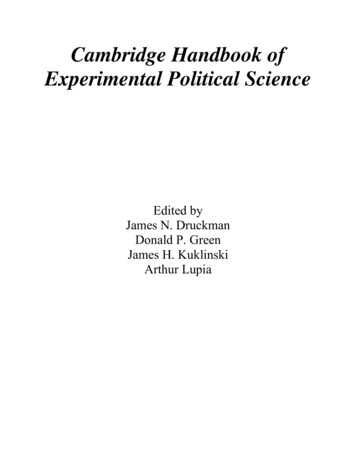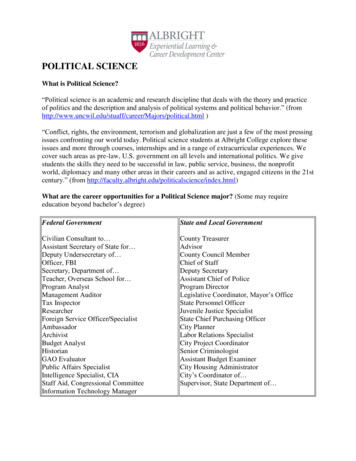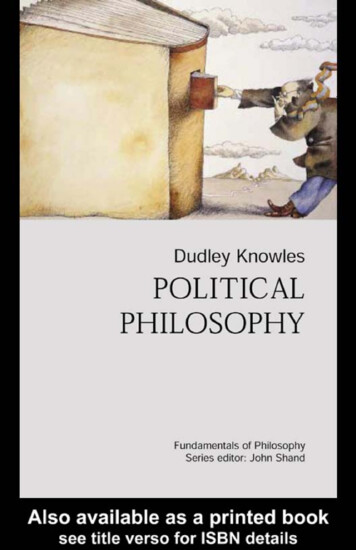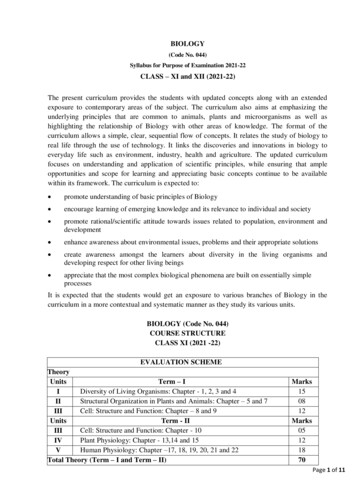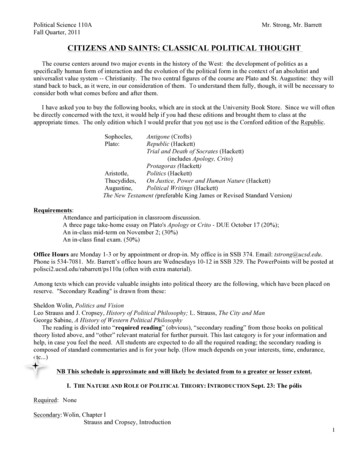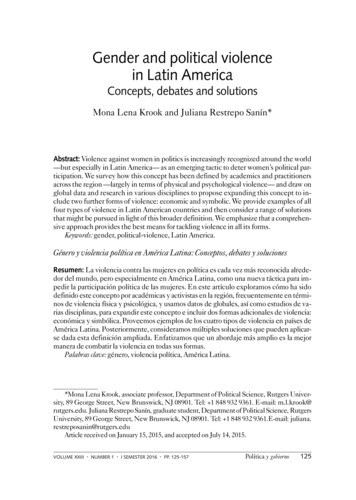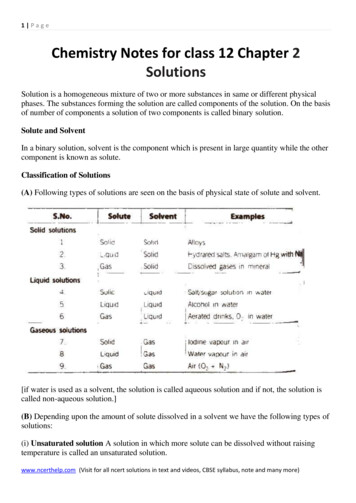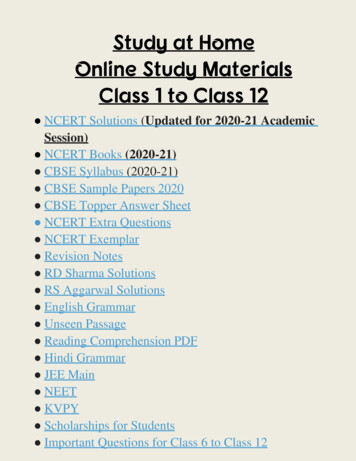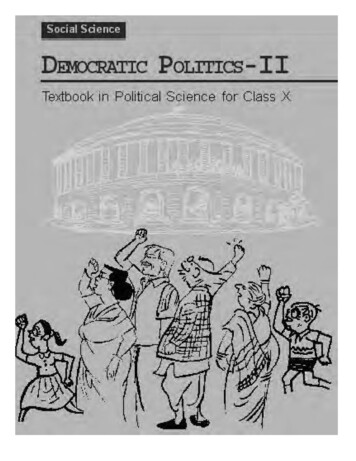
Transcription
ContentsForewordA Letter for YouiiivUnit IChapter 1Power sharing1Chapter 2Federalism13Unit IIChapter 3Democracy and Diversity29Chapter 4Gender, Religion and Caste39Unit IIIChapter 5Popular Struggles and Movements57Chapter 6Political Parties71Unit IVChapter 7Outcomes of Democracy89Chapter 8Challenges to Democracy101
❲ s s s s ❲ s s s s s s s s s s s s ❲ s s s s s s s s s s s s s s s s s s s ss s s s s P1
I have a simpleequation in mind.Sharing power dividing power weakening thecountry. Why do westart by talking ofthis?Belgium is a small country in Europe,smaller in area than the state ofHaryana. It has borders withNetherlands, France and Germany. Ithas a population of a little over onecrore, about half the population ofHaryana. The ETHNIC composition ofthis small country is very complex. Ofthe country’s total population, 59 percent lives in the Flemish region andspeaks Dutch language. Another 40 percent people live in the Wallonia regionand speak French. Remaining 1 per centof the Belgians speak German. In thecapital city Brussels, 80 per cent peoplespeak French while 20 per cent areDutch-speaking.The minority French-speakingcommunity was relatively rich andpowerful. This was resented by theDutch-speaking community who gotthe benefit of economic developmentand education much later. This led totensions between the Dutch-speakingand French-speaking communitiesduring the 1950s and 1960s. Thetension between the two communitieswas more acute in Brussels. Brusselspresented a special problem: theDutch-speaking people constituted amajority in the country, but a minorityin the capital.Let us compare this to the situationin another country. Sri Lanka is anisland nation, just a few kilometres offthe southern coast of Tamil Nadu. Ithas about 2 crore people, about thesame as in Haryana. Like other nationsin the South Asia region, Sri Lanka hasa diverse population. The major socialgroups are the Sinhala-speakers (74 percent) and the Tamil-speakers (18 percent). Among Tamils there are two subgroups. Tamil natives of the country 2Ethnic: A socialdivision based onshared culture. Peoplebelonging to the sameethnic group believe intheir common descentbecause of similaritiesof physical type or ofculture or both. Theyneed not always havethe same religion ornationality. WikipediaCommunitiesandregions ofBelgiumBrussels-Capital RegionWalloon (French-speaking)Flemish (Dutch-speaking)German-speakingLook at the maps of Belgium and Sri Lanka. In whichregion do you find concentration of differentcommunities?
are called ‘Sri Lankan Tamils’ (13 percent). The rest, whose forefathers camefrom India as plantation workers duringcolonial period, are called ‘IndianTamils’. As you can see from the map,Sri Lankan Tamils are concentrated inthe north and east of the country. Mostof the Sinhala-speaking people areBuddhist, while most of the Tamils areHindus or Muslims. There are about 7per cent Christians, who are both Tamiland Sinhala.Just imagine what could happenin situations like this. In Belgium, theDutch community could takeadvantage of its numeric majority andforce its will on the French andGerman-speaking population. Thiswould push the conflict amongcommunities further. This could leadto a very messy partition of thecountry; both the sides would claimcontrol over Brussels. In Sri Lanka, theSinhala community enjoyed an evenbigger majority and could impose itswill on the entire country. Now, let uslook at what happened in both thesecountries. Sri Lanka emerged as an independentcountry in 1948. The leaders of theSinhala community sought to securedominance over government by virtueof their majority. As a result, thedemocratically elected governmentadopted a series of MAJORITARIANmeasures to establish Sinhala supremacy.In 1956, an Act was passed torecognise Sinhala as the only officiallanguage, thus disregarding Tamil. Thegovernments followed preferentialpolicies that favoured Sinhalaapplicants for university positions andgovernment jobs. A new constitutionstipulated that the state shall protectand foster Buddhism.All these government measures,coming one after the other, graduallyincreased the feeling of alienationamong the Sri Lankan Tamils. They feltthat none of the major political partiesled by the Buddhist Sinhala leaderswere sensitive to their language andculture. They felt that the constitutionand government policies denied themequal political rights, discriminatedagainst them in getting jobs and otheropportunities and ignored theirinterests. As a result, the relationsEthnic Communitiesof Sri LankaSinhaleseSri Lankan TamilIndian TamilMuslimMajoritarianism: Abelief that the majoritycommunity should beable to rule a country inwhichever way it wants,by disregarding thewishes and needs of theminority. P3
What ’s wrong ift he m aj orit ycom m unit yrules? I f Sinhalasdon’t rule in SriLanka, whereelse will t heyrule?between the Sinhala and Tamilcommunities strained over time.The Sri Lankan Tamils launchedparties and struggles for the recognitionof Tamil as an official language, forregional autonomy and equality ofopportunity in securing education andjobs. But their demand for moreautonomy to provinces populated bythe Tamils was repeatedly denied. By1980s several political organisationswere formed demanding anindependent Tamil Eelam (state) innorthern and eastern parts of Sri Lanka.The distrust between the twocommunities turned into widespreadconflict. It soon turned into a CIVIL WAR.As a result thousands of people of boththe communities have been killed. Manyfamilies were forced to leave the countryas refugees and many more lost theirlivelihoods. You have read (Chapter 1of Economics textbook, Class X) aboutSri Lanka’s excellent record of economicdevelopment, education and health. Butthe civil war has caused a terrible setbackto the social, cultural and economic lifeof the country. Civil war: A violentconflict betweenopposing groups withina country that becomesso intense that it appearslike a war. The Belgian leaders took a differentpath. They recognised the existence ofregional differences and culturaldiversities. Between 1970 and 1993,they amended their constitution fourtimes so as to work out an arrangementthat would enable everyone to livetogether within the same country. Thearrangement they worked out isdifferent from any other country andis very innovative. Here are some ofthe elements of the Belgian model: Constitution prescribes that thenumber of Dutch and French-speakingministers shall be equal in the centralgovernment. Some special laws requirethe support of majority of membersfrom each linguistic group. Thus, nosingle community can make decisionsunilaterally. Many powers of the centralgovernment have been given to stategovernments of the two regions of thecountry. The state governments are notsubordinate to the Central Government. Brussels has a separate governmentin which both the communities haveequal representation. The Frenchspeaking people accepted equalrepresentation in Brussels because theDutch-speaking community hasaccepted equal representation in theCentral Government. 4What kind of a solut ion ist his? I am glad ourConst it ut ion does not saywhich m inist er will com e fromwhich com m unit y. Wikipedia The photograph here is of a streetaddress in Belgium. You will notice thatplace names and directions in twolanguages – French and Dutch.
Apart from the Central andthe State Government, there is athird kind of government. This‘community government’ is elected bypeople belonging to one languagecommunity – Dutch, French andGerman-speaking – no matter wherethey live. This government has thepower regarding cultural, educationaland language-related issues.You might find the Belgian modelvery complicated. It indeed is verycomplicated, even for people living inBelgium. But these arrangements haveworked well so far. They helped toavoid civic strife between the twomajor communities and a possibledivision of the country on linguisticlines. When many countries of Europecame together to form the European European Union Parliament in BelgiumUnion, Brussels was chosen as itsheadquarters.Read any newspaper for one week and m ake clippings ofnews relat ed t o ongoing conflict s or wars. A group of fivest udent s could pool t heir clippings t oget her and do t he following:Classify t hese conflict s by t heir locat ion ( your st at e, I ndia,out side I ndia) .Find out t he cause of each of t hese conflict s. How m any oft hese are relat ed t o power sharing disput es?Which of t hese conflict s could be resolved by working out powersharing arrangem ent s?What do we learn from these two storiesof Belgium and Sri Lanka? Both aredemocracies. Yet, they dealt with thequestion of power sharing differently.In Belgium, the leaders have realisedthat the unity of the country is possibleonly by respecting the feelings andinterests of different communities andregions. Such a realisation resulted inmutually acceptable arrangements forsharing power. Sri Lanka shows us acontrasting example. It shows us thatif a majority community wants to forceits dominance over others and refusesto share power, it can undermine theunity of the country.So you aresaying t hatsharing of powerm akes us m orepowerful. Soundsodd! Let m et hink. P5
Tab - The Calgary Sun, Cagle Cartoons Inc.Why power sharing is desirable?Thus, two different sets of reasons canbe given in favour of power sharing.Firstly, power sharing is good becauseit helps to reduce the possibility ofconflict between social groups. Sincesocial conflict often leads to violenceand political instability, power sharingis a good way to ensure the stability ofpolitical order. Imposing the will ofmajority community over others maylook like an attractive option in theshort run, but in the long run itundermines the unity of the nation.The cartoon at the left refers to theproblems of running the Germany’s grandcoalition government that include the twomajor parties of the country, namely theChristian Democratic Union and theSocial Democratic Party. The two partiesare historically rivals to each other. Theyhave to form a coalition governmentbecause neither of them got clear majorityof seats on their own in the 2005elections. They take divergent positionson several policy matters, but still jointlyrun the government.Tyranny of the majority is not justoppressive for the minority; it oftenbrings ruin to the majority as well.There is a second, deeper reasonwhy power sharing is good fordemocracies. Power sharing is the veryspirit of democracy. A democratic ruleinvolves sharing power with thoseaffected by its exercise, and who haveto live with its effects. People have aright to be consulted on how they areto be governed. A legitimategovernment is one where citizens,through participation, acquire a stakein the system.Let us call the first set of reasonsPRUDENTIAL and the second moral. Whileprudential reasons stress that powersharing will bring out better outcomes,moral reasons emphasises the very actof power sharing as valuable. Prudential: Based onprudence, or on carefulcalculation of gains andlosses. Prudential decisionsare usually contrasted withthose decisions basedpurely on moralconsiderations. 6Annet t e st udies in a Dut ch m edium school in t henort hern region of Belgium . Many French- speaking st udent s inher school want t he m edium of inst ruct ion t o be French. Selvist udies in a school in t he nort hern region of Sri Lanka. All t hest udent s in her school are Tam il- speaking and t hey want t hem edium of inst ruct ion t o be Tam il.I f t he parent s of Annet t e and Selvi were t o approachrespect ive governm ent s t o realise t he desire of t he childwho is m ore likely t o succeed? And why?
Khalil’sdilemmaAs usual, Vikram ’s was driving t he m ot orbike under a vowof silence and Vet al was t he pillion rider. As usual, Vet alst art ed t elling Vikram a st ory t o keep him awake whiledriving. This t im e t he st ory went as follows:“ I n t he cit y of Beir ut t her e lived a m an called Khalil. His par ent scam e fr om differ ent com m unit ies. His fat her was an Or t hodox Chr ist ian and m ot her aSunni Muslim . This was not so uncom m on in t his m oder n, cosm opolit an cit y. Peoplefr om var ious com m unit ies t hat lived in Lebanon cam e t o live in it s capit al, Beir ut . Theylived t oget her, int er m ingled, yet fought a bit t er civ il war am ong t hem selves. One ofKhalil’s uncles w as k illed in t hat war.At t he end of t his civil war, Lebanon’s leaders cam e t oget her and agreed t o som e basicrules for power sharing am ong different com m unit ies. As per t hese rules t he count ry’sPresident m ust belong t o t he Maronit e sect of Cat holic Christ ians. The Prim e Minist erm ust be from t he Sunni Muslim com m unit y. The post of Deput y Prim e Minist er is fixed forOrt hodox Christ ian sect and t hat of t he Speaker for Shi’a Muslim . Under t his pact , t heChrist ians agreed not t o seek French prot ect ion and t he Muslim agreed not t o seekunificat ion wit h t he neighbouring st at e of Syria.When t he Christ ians and Muslim s cam e t ot his agreem ent , t hey were nearly equal in populat ion. Bot h sides have cont inued t orespect t his agreem ent t hough now t he Muslim s are in clear m aj orit y.Khalil does not like t his sy st em one bit . He is a popular m an w it h polit ical am bit ion. Butunder t he pr esent sy st em t he t op posit ion is out of his r each bar r ed fr om him . He doesnot pract ice eit her his fat her ’s or his m ot her ’s r eligion and does not w ish t o be k now nby eit her. He cannot under st and w hy Lebanon can’t be like any ot her ‘nor m al’dem ocracy. “ Just hold an elect ion, allow ever yone t o cont est and w hoever w insm ax im um vot es becom es t he pr esident , no m at t er w hich com m unit y he com es fr om .Why can’t w e do t hat , like in ot her dem ocracies of t he w or ld?” he ask s. His elder s, w hohave seen t he bloodshed of t he civ il war, t ell him t hat t he pr esent sy st em is t he bestguarant ee for peace ”The st ory was not finished, but t hey had reached t he TVt ower where t hey st opped every day. Vet alwrapped up quickly and posed hiscust om ary quest ion t o Vikram : “ I f you hadt he power t o rewrit e t he rules in Lebanon,what would you do? Would you adopt t he‘regular ’ rules followed everywhere, as Khalilsuggest s? Or st ick t o t he old rules? Or do som et hing else?” Vet al did not forget t o rem ind Vikram of t heir basic pact : “ I f you have an answer in m ind and yet do not speak up, your m obike will freeze, and so will you!”Ca n you h e lp poor Vik r a m in a n sw e r in g Ve t a l? P7
The idea of power sharing hasemerged in opposition to the notionsof undivided political power. For along time it was believed that all powerof a government must reside in oneperson or group of persons locatedat one place. It was felt that if thepower to decide is dispersed, it wouldnot be possible to take quick decisionsand to enforce them. But thesenotions have changed with theemergence of democracy. One basicprinciple of democracy is that peopleare the source of all political power.In a democracy, people rulethemselves through institutions ofself-governance. In a good democraticgovernment, due respect is given todiverse groups and views that exist ina society. Everyone has a voice in theshaping of public policies. Therefore,it follows that in a democracy political Olle Johansson - Sweden, Cagle Cartoons Inc.Reigning Reins 8Recently some new laws were made in Russia giving more powers toits president. During the same time the US president visited Russia.What, according to this cartoon, is the relationship between democracyand concentration of power? Can you think of some other examples toillustrate the point being made here?power should be distributed amongas many citizens as possible.In modern democracies, powersharing arrangements can take manyforms. Let us look at some of the mostcommon arrangements that we haveor will come across.1 Power is shared among differentorgans of government, such as thelegislature, executive and judiciary. Letus call this horizontal distribution ofpower because it allows different organsof government placed at the same levelto exercise different powers. Such aseparation ensures that none of theorgans can exercise unlimited power.Each organ checks the others. Thisresults in a balance of power amongvarious institutions. Last year we studiedthat in a democracy, even thoughministers and government officialsexercise power, they are responsible tothe Parliament or State Assemblies.Similarly, although judges are appointedby the executive, they can check thefunctioning of executive or laws madeby the legislatures. This arrangement iscalled a system of checks and balances.2 Power can be shared amonggovernments at different levels – ageneral government for the entirecountry and governments at theprovincial or regional level. Such ageneral government for the entirecountry is usually called federalgovernment. In India, we refer to itas the Central or Union Government.The governments at the provincial orregional level are called by differentnames in different countries. In India,
we call them State Governments. Thissystem is not followed in all countries.There are many countries where thereare no provincial or stategovernments. But in those countrieslike ours, where there are differentlevels of gover nments, theconstitution clearly lays down thepowers of different levels ofgovernment. This is what they did inBelgium, but was refused in Sri Lanka.This is called federal division ofpower. The same principle can beextended to levels of governmentlower than the State government, suchas the municipality and panchayat. Letus call division of powers involvinghigher and lower levels ofgovernment vertical division ofpower. We shall study these at somelength in the next chapter.3 Power may also be shared amongdifferent social groups, such as thereligious and linguistic groups.‘Community government’ in Belgiumis a good example of this arrangement.In some countries there areconstitutional and legal arrangementswhereby socially weaker sections andwomen are represented in thelegislatures and administration. Lastyear we studied the system of ‘reservedconstituencies’ in assemblies and theparliament of our country. This typeof arrangement is meant to give spacein the government and administrationto diverse social groups who otherwisewould feel alienated from thegovernment. This method is used togive minority communities a fair sharein power. In Chapter 3, we shall lookat various ways of accommodatingsocial diversities.4 Power sharing arrangements canalso be seen in the way politicalparties, pressure groups andmovements control or influence thosein power. In a democracy, the citizensmust have freedom to choose amongvarious contenders for power. Incontemporary democracies this takesthe form of competition amongdifferent parties. Such competitionensures that power does not remain inone hand. In the long run power isshared among different political partiesthat represent different ideologies andsocial groups. Sometimes this kind ofsharing can be direct, when two ormore parties form an alliance tocontest elections. If their alliance iselected, they for m a coalitiongovernment and thus share power. Ina democracy, we find interest groupssuch as those of traders, businessmen,industrialists, farmers and industrialworkers. They also will have a share ingovernmental power, either throughparticipation in governmentalcommittees or bringing influence onthe decision making process. InChapter 4, we shall study the workingof political parties, pressure groups andsocial movements.I n m y school, t heclass m onit orchanges everym ont h. I s t hatwhat you call apower sharingarrangem ent ? P9
Here are som e exam ples of power sharing. Which of t he four t ypes of powersharing do t hese represent ? Who is sharing power wit h whom ?The Bom bay High Court ordered t he Maharasht ra st at e governm ent t o im m ediat elyt ake act ion and im prove living condit ions for t he 2,000- odd children at sevenchildren’s hom es in Mum bai.The governm ent of Ont ario st at e in Canada has agreed t o a land claim set t lem ent wit ht he aboriginal com m unit y. The Minist er responsible for Nat ive Affairs announced t hatt he governm ent will work wit h aboriginal people in a spirit of m ut ual respect andco- operat ion.Russia’s t wo influent ial polit ical part ies, t he Union of Right Forces and t he LiberalYabloko Movem ent , agreed t o unit e t heir organisat ions int o a st rong right- wingcoalit ion. They propose t o have a com m on list of candidat es in t he nextparliam ent ary elect ions.The finance m inist ers of various st at es in Nigeria got t oget her and dem anded t hatt he federal governm ent declare it s sources of incom e. They also want ed t o know t heform ula by which t he revenue is dist ribut ed t o various st at e governm ent s.1.What are t he different form s of power sharing in m oderndem ocracies? Give an exam ple of each of t hese.2.St at e one prudent ial reason and one m oral reason for powersharing wit h an exam ple from t he I ndian cont ext .3.Aft er reading t his chapt er, t hree st udent s drew differentconclusions. Which of t hese do you agree wit h and why? Giveyour reasons in about 50 words.Thom m an - Power sharing is necessary only in societ ies whichhave religiousm , linguist ic or et hnic divisions.Mat hayi – Power sharing is suit able only for big count ries t hathave regional divisions.Ouseph – Every societ y needs som e form of power sharing evenif it is sm all or does not have social divisions.4.The Mayor of Mercht em , a t own near Brussels in Belgium , hasdefended a ban on speaking French in t he t own’s schools. Hesaid t hat t he ban would help all non- Dut ch speakers int egrat ein t his Flem ish t own. Do you t hink t hat t his m easure is inkeeping wit h t he spirit of Belgium ’s power sharingarrangem ent s? Give your reasons in about 50 words. 10
5.Read t he following passage and pick out any one of t heprudent ial reasons for power sharing offered in t his.“ We need t o give m ore power t o t he panchayat s t o realise t hedream of Mahat m a Gandhi and t he hopes of t he m akers of ourConst it ut ion. Panchayat i Raj est ablishes t rue dem ocracy. I trest ores power t o t he only place where power belongs in adem ocracy – in t he hands of t he people. Giving power t oPanchayat s is also a way t o reduce corrupt ion and increaseadm inist rat ive efficiency. When people part icipat e in t he planningand im plem ent at ion of developm ent al schem es, t hey wouldnat urally exercise great er cont rol over t hese schem es. This wouldelim inat e t he corrupt m iddlem en. Thus, Panchayat i Raj willst rengt hen t he foundat ions of our dem ocracy.”6.Different argum ent s are usually put fort h in favour of and againstpower sharing. I dent ify t hose which are in favour of power sharingand select t he answer using t he codes given below? Power sharing:A.B.C.D.E.F.G.reduces conflict am ong different com m unit iesdecreases t he possibilit y of arbit rarinessdelays decision m aking processaccom m odat es diversit iesincreases inst abilit y and divisivenessprom ot es people’s part icipat ion in governm entunderm ines t he unit y of a count ry( a)( b)( c)( d)7.AAABBCBCDEDDFFGGConsider t he following st at em ent s about power sharingarrangem ent s in Belgium and Sri Lanka.A. I n Belgium , t he Dut ch- speaking m aj orit y people t ried t o im poset heir dom inat ion on t he m inorit y French- speaking com m unit y.B. I n Sri Lanka, t he policies of t he governm ent sought t o ensure t hedom inance of t he Sinhala- speaking m aj orit y.C. The Tam ils in Sri Lanka dem anded a federal arrangem ent ofpower sharing t o prot ect t heir cult ure, language and equalit y ofopport unit y in educat ion and j obs.D. The t ransform at ion of Belgium from unit ary governm ent t o afederal one prevent ed a possible division of t he count ry onlinguist ic lines. Which of t he st at em ent s given above are correct ? ( a) A, B, C and D( b) A, B and D( c) C and D( d) B, C and D P11
8.Match List I ( form s of power sharing) with List I I ( form s of governm ent)and select t he correct answer using t he codes given below in t he list s:1.List IList I IPower shared am ong differentorgans of governm entA. Com m unit y governm ent2.Power shared am ong governm ent sat different levelsB. Separat ion of powers3.Power shared by different socialgroupsC. Coalit ion governm entPower shared by t wo or m orepolit ical part iesD. Federal governm ent4.( a)( b)( c)( d)9.1DBBC2ACDD3BDAA4CACBConsider t he following t wo st at em ent s on power sharing andselect t he answer using t he codes given below:A. Power sharing is good for dem ocracy.B. I t helps to reduce the possibility of conflict between social groups.Which of t hese st at em ent s are t rue and false?( a)( b)( c)( d) 12A is t rue but B is falseBot h A and B are t rueBot h A and B are falseA is false but B is t rue
s 13
❲ Let us get back to the contrast betweenBelgium and Sri Lanka that we saw inthe last chapter. You would recall thatone of the key changes made in theConstitution of Belgium was to reducethe power of the Central Governmentand to give these powers to the regionalgovernments. Regional governmentsexisted in Belgium even earlier. Theyhad their roles and powers. But all thesepowers were given to thesegovernments and could be withdrawnby the Central Government. Thechange that took place in 1993 was thatthe regional governments were givenconstitutional powers that were nolonger dependent on the centralgovernment. Thus, Belgium shiftedfrom a unitary to a federal form ofgovernment. Sri Lanka continues to be,I am confused.What do we callt he I ndiangovernm ent ? I sit Union, Federalor Cent ral?for all practical purposes, a unitarysystem where the national governmenthas all the powers. Tamil leaders wantSri Lanka to become a federal system.Federalism is a system ofgovernment in which the power isdivided between a central authority andvarious constituent units of thecountry. Usually, a federation has twolevels of government. One is thegovernment for the entire country thatis usually responsible for a few subjectsof common national interest. Theothers are governments at the level ofprovinces or states that look aftermuch of the day-to-day administeringof their state. Both these levels ofgovernments enjoy their powerindependent of the other.Federalpolitical nited Statesof AmericaSt. Kittsand NevisMexico PACIFIC OCEAN EthiopiaATLANTICOCEANArgentina IndiaPACIFIC ustraliaMicronesia South AfricaSource: Montreal and Kingston, Handbook of Federal Countries: 2002, McGill-Queen’s University Press, 2002. 14BrazilBosnia and PakistanHerzegovinaNigeriaVenezuela AustriaThough only 25 of the world’s 192 countries have federal political systems, their citizens make up 40 per cent ofthe world’s population. Most of the large countries of the world are federations. Can you notice an exception to thisrule in this map?
In this sense, federations arecontrasted with unitary governments.Under the unitary system, either thereis only one level of government or thesub-units are subordinate to the centralgovernment. The central governmentcan pass on orders to the provincial orthe local government. But in a federalsystem, the central government cannotorder the state government to dosomething. State government haspowers of its own for which it is notanswerable to the central government.Both these governments are separatelyanswerable to the people.Let us look at some of the keyfeatures of federalism :1 There are two or more levels (ortiers) of government.2 Different tiers of governmentgovern the same citizens, but each tierhas its own JURISDICTION in specificmatters of legislation, taxation andadministration.3 The jurisdictions of the respectivelevels or tiers of government arespecified in the constitution. So theexistence and authority of each tier ofgovernment is constitutionallyguaranteed.4 The fundamental provisions ofthe constitution cannot be unilaterallychanged by one level of government.Such changes req
speak French while 20 per cent are Dutch-speaking. The minority French-speaking community was relatively rich and powerful. This was resented by the Dutch-speaking community who got the benefit of economic development and education much later. This led to tensions between the Dutch-speaking and French-speaking communities during the 1950s and .
